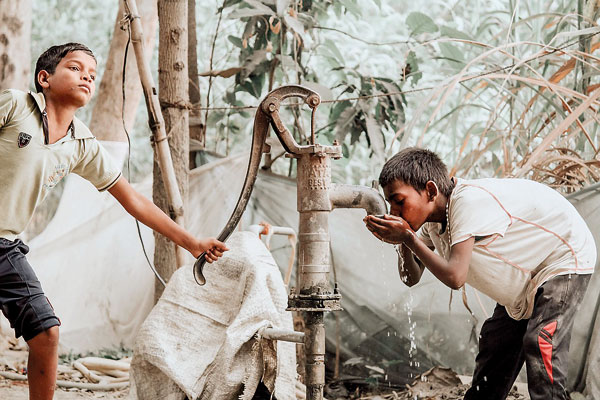News
Sweltering conditions put young lives and learning at risk
View(s):By Malaka Rodrigo
Although the annual school sports events concluded without major incidents this year despite the rising heat, the traditional Aluth Avurudu games — once a source of joy for children — now warrant extra caution in the face of a changing climate.
In March 2024, sixteen-year-old Vidurshan, a student from Ampara in Eastern Sri Lanka, collapsed midway through the inter-house marathon event. He died in hospital.
The post-mortem by the Judicial Medical Officer, issued an open verdict, but the signs were clear that the student faced a heat stroke-related illness.

This tragedy unfolded during one of the hottest months Sri Lanka has experienced in recent times.
“Many factors can contribute to heat stroke, but high environmental temperature is the dominant cause,” said Dr. Lal Ekanayake, director general of the Institute of Sports Medicine, highlighting the dangers of outdoor physical exertion in extreme heat.
Deaths during sports events or physically demanding activities are often attributed to heart issues. However, these cardiac events can themselves be triggered by high temperatures, noted Dr. Ekanayake.
“When the body is stressed by heat, the heart rate increases to regulate internal temperature. But heavy sweating leads to loss of vital minerals and electrolytes, disrupting heart signals and potentially causing heart arrhythmia — one of the leading causes of sudden deaths during sports,” Dr. Ekanayake told Sunday Times.
What makes Vidurshan’s case even more tragic is that it could have been prevented. Just weeks before the event, the Education Ministry had advised schools to postpone sports meets until late April due to soaring temperatures. Such warnings are not new. Over the past five years, the ministry has issued heat stroke alerts to schools during the hot season on four occasions .
“We issue these heat stress warnings considering the recommendations we received, but regional-level decisions are permitted based on the severity of heat experienced in each area,” says Sujatha Kulendrakumar, deputy director of education at the Ministry of Education.
In Sri Lanka, the districts most affected by extreme heat are in the Dry Zone and parts of the Intermediate Zone. Areas such as Anuradhapura, Polonnaruwa, Trincomalee, Batticaloa, Ampara, Vavuniya, Mannar, Monaragala, and Hambantota often record the highest temperatures in the country and it is expected that global warming will make things particularly worst for these areas.
“Children hardly get time to play outdoors anymore, and now even that is affected by the heat,” lamented retired civil servant Indrasena Muthukumarana, 82. “In our time, we were always outside playing or engaged in other activities at our leisure times, but the heat never bothered us like this.” Mr Muthukumarana’s observations are backed by scientific evidence. A World Bank report titled ‘The Impact of Climate Change on Education and What to Do about It’ published last year reveals that a child born in 2024 will face twice as many wildfires and tropical cyclones, three times more river floods, four times more crop failures, and five times more droughts in a warmer world than a child born in 1970.
The rising heat is not only a threat to physical safety but also to education as the World Bank Report also highlights that extreme heat can lead to learning losses. While small shifts in average temperatures might seem negligible, they accumulate over time — especially in already hot regions — resulting in significant setbacks in education. Performance on exams drops noticeably on hotter days, disproportionately affecting students in poorer, less-equipped schools, the publication stated.
Extracurricular activities like physical education, sports, and field trips are frequently canceled during heatwaves, further impacting children’s holistic development, which has become common in this part of the world according to this report.
In Sri Lanka, many rural schools lack fans or air conditioning. “Heat in classrooms on some days become unbearable, so high temperatures lead to fatigue and lower alertness,” noted Science teacher Suneetha Ramanayake. “Not just students – teachers, too, feel the heat which affects total quality of the teaching.
Conditions could be worse in tuition classes, as some are held in makeshift huts with tin-sheet roofs. Such premises turn into ovens under the midday sun. Even electric fans can’t offset such intense heat, Ms Ramanayake said.
The current hot weather is expected to last until May, until monsoon winds start to sweep across Sri Lanka warns, Dr. Anusha Warnasuriya, a forecasting director of the Meteorology Department. While average temperatures in Sri Lanka have increased only slightly, it’s the combination of heat and humidity that makes the situation dangerous. “When there’s high humidity, sweat doesn’t evaporate easily, so the body can’t cool itself — from February to May, limited wind and cloudless skies make things worse.” said Dr. Warnasooriya.
To alert the public, the Department of Meteorology of Sri Lanka uses a Heat Index Advisory system. This system calculates the apparent temperature by factoring in both the air temperature and relative humidity, offering a more accurate reflection of how hot it feels to the human body. Warnings are issued using a colour-coded system, ranging from green for normal conditions to dark red for extreme danger, where heat stroke is imminent.
A recent UNICEF report showed that in 2024, heat-related events became the most significant climate hazard disrupting education globally, affecting an estimated 171 million students. In Asia, the highest disruptions were in April, with heatwaves impacting at least 118 million children.
Sri Lanka is highly vulnerable to climate change and has consistently ranked among the countries most affected by extreme weather events, being ranked No 2 in the Global Climate Risk Index of 2019. The country has already experienced a temperature rise of about 0.8 to 1.0°C, and projections indicate a further increase of 1.0 to 1.2°C by 2030, potentially reaching up to 4°C by the end of the century under high-emission scenarios.
Even after the school sports season ends, risks remain. April also brings traditional Avurudu games such as marathons and bicycle races held at the village level. “We’ve recorded deaths during these games, too,” said Dr. Ekanayake.
To address the issue, Sri Lanka issued a set of guidelines particularly for event organisers of sports events, also covering heat-related illnesses. These guidelines include being in close contact with nearby hospitals for emergencies and ensuring events start early to avoid the peak heat. “Don’t delay the start waiting for politicians or chief guests — it’s safer to begin before the sun gets too harsh,” Dr. Ekanayake advised.
As Sri Lanka faces increasingly extreme weather, it is crucial for schools, communities, and policymakers to adapt and prioritise the safety and well-being of children — both in sports and in learning, Dr. Ekanayake said.
This story was produced under the CIR-CANSA Media Fellowship Programme.
The best way to say that you found the home of your dreams is by finding it on Hitad.lk. We have listings for apartments for sale or rent in Sri Lanka, no matter what locale you're looking for! Whether you live in Colombo, Galle, Kandy, Matara, Jaffna and more - we've got them all!

